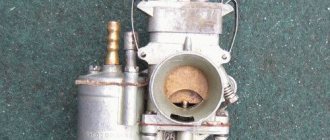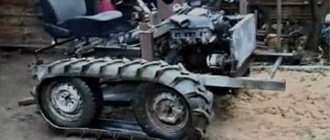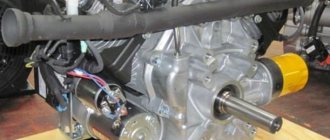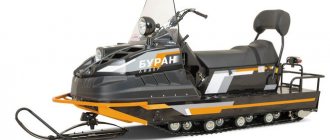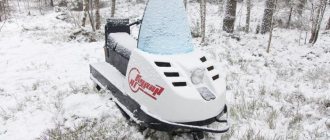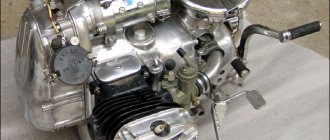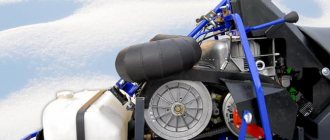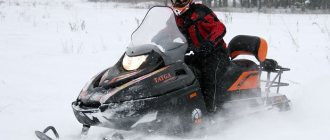Specifications
Description and technical characteristics of Buran-640:
| Front suspension type | Spring |
| Rear suspension type | Independent |
| Number of front springs | 1 |
| Number of tracks | 2 |
| Tension mechanism | Screw |
| Gearbox model | Variable speed drive |
| Number of gears | 4 |
| Reverse | Eat |
| Brake system type | Disk |
| Brake drive | Mechanical |
| Powertrain starting system | Manual, electric starter |
| Ignition | Contactless |
| Lubrication system | Combined (gasoline and oil) |
| Number of seats | 2 |
| Permissible towed load weight | 250 kg |
| Speedometer | Eat |
| Heated grips | Eat |
| Headlight | 55/60, halogen |
| Taillight | LED |
| Piston stroke | 7 cm |
| Fuel used | Gasoline AI-92, AI-76, AI-80 |
| Carburetor model | Mikuni |
| Power unit model | RMZ-640 |
| Diameter of cylindrical elements | 7.6 cm |
| Type of working fluid cooling system | Air |
| International environmental standard | Euro 2 |
| Fuel tank volume | 28 l |
Dimensional data
Overall dimensions of the Buran ADE snowmobile track:
- length - 2.87 m;
- width - 0.38 m;
- height - 0.075 m.
Vehicle dimensions: 2.7 * 0.91 * 1.33 m, weight - 285 kg.
Box dimensions
Buran 4TD is equipped with boxes whose size is 2.42 * 1.06 * 1.13 m.
Suspension
There is an elliptic spring front suspension and an independent rear suspension equipped with a balanced spring.
The travel of the front and rear mechanisms is 5 cm. The number of front springs is 1.
The snowmobile suspension design includes the following elements:
- bearing shell;
- outer hub;
- star;
- internal type hub;
- shaft;
- mounting bolts and nuts;
- sleeve;
- video clip;
- ski;
- axial device;
- clamp;
- buffer;
- steering column;
- cuff;
- thrust washer;
- sprocket driven type of chain drive;
- retaining ring.
The spring assemblies are attached to the ski sole brackets. The ends of the root sheet should be secured with cotter pins. The longitudinal movement of the springs is carried out by sliding along the bronze liner of the front tip of the main leaf.
The bearings, pin and guide axis of the handle must be treated with special lubricant.
Mover
This snowmobile is equipped with a caterpillar drive unit equipped with drive-type sprockets. Number of track mechanisms - 2. Type of track - reinforced with plastic rods, made of rubber and fabric. The tension mechanism is screw, the height of the lug devices is 17.5 mm.
The propulsion unit converts the energy of the power unit through interaction with the environment. The traction force is created by rewinding the caterpillar tracks.
The large contact area of the tracked belt device with the soil makes it possible to ensure low ground pressure and a high level of maneuverability.
The propulsion device includes the following mechanisms:
- drive wheel;
- caterpillars;
- track rollers;
- support rollers;
- tension mechanism with sloths.
This mechanism allows you to increase maneuverability and extend the life of the vehicle.
Transmission
This snowmobile has a transmission in the form of a variator and gearbox. The variator consists of a V-belt drive with automatic change in the working diameter of the drive shaft of the Buran snowmobile track.
The variator design includes:
- a drive pulley equipped with a centrifugal regulating device;
- driven pulley equipped with a cam-type clutch.
The gearbox consists of:
- crankcase;
- reverse shaft;
- gear shift devices;
- chain tensioner.
The gear shift mechanism is installed on the housing cover and consists of an axle device, a shift fork, and a spring-loaded ball that fits into the groove of the axle. A plastic plug with a venting hole is screwed into the lid.
The tensioner is located at the bottom of the housing. The tension is adjusted by turning the tension shaft. To check the chain, the design includes a special inspection ring.
Brakes
The snowmobile is equipped with mechanically driven disc brakes. The design of the brake system includes the following mechanisms:
- main brake cylinder block;
- vacuum type amplifier;
- a device that regulates pressure in the rear brake mechanism;
- ABS unit;
- working brake cylindrical elements;
- working circuits.
The main brake cylinder converts the traction force, which is transmitted from the brake pedal, into fuel fluid pressure in the system and distributes it across all operating circuits.
In order to increase the force that creates pressure, a vacuum hydraulic drive booster is needed.
The regulating device reduces the pressure level in the brake drive of the rear wheel elements, which makes it possible to increase the braking efficiency of vehicles.
The circuits consist of closed pipelines that connect the main cylinders and wheels.
Operating Parameters
Overview of operating parameters:
| Engine starting | Electric starter |
| Maximum driving speed | 60 km/h |
| Exhaust system | Muffler with resonator |
| Intake system | Noise-intake silencer |
| Weight | 285 kg |
| Fuel | Petrol |
Basic equipment
The basic package includes:
- starter;
- reverse type transmission;
- heated handles;
- windshield;
- rear towbar;
- speedometer;
- odometer.
Lighting engineering
This modification of the snowmobile is equipped with projector headlights model 17.3711010. They consist of a body, a bezel and an optical device. The lamp is attached to the optical mechanism using a spring latch. There are 3 pins that are needed to connect the plug connector. Using screws, you can adjust the headlights in a horizontal or vertical position.
The rear light is located on the rear suspension housing, to which it is attached with two screws. The design of the lantern includes: base, lamp, socket, glass.
There are 2 safety devices on the vehicle: 15 A and 30 A. They are designed to protect the electrical circuit of the ignition system and engine.
The brake light is located on the steering handle. It turns on the snowmobile handbrake lamp by closing the switch contacts.
Engine
The Buran RMZ-640 snowmobile engine has the following technical indicators:
| Engine type | Two-stroke, with crank chamber |
| Number of cylindrical elements | 2 |
| Cylinder arrangement | Vertical |
| Cylinder diameter | 7.6 cm |
| Piston stroke | 7 cm |
| Engine displacement | 6.35 l |
| Compression ratio | 8,2 |
| Maximum motor power | 34 l. With. |
| Maximum torque | 1300 rpm |
| Average fuel consumption | 4 l |
| Fuel pump type | Diaphragm |
| Ignition system | Contactless |
| Starter model | ST362 |
| Weight | 50 kg |
| Rated voltage | 12 V |
Some models are equipped with a Lifan engine for the Buran snowmobile. Technical indicators:
| Power unit power | 13 l. With. |
| Starting system | Manual |
| Average gas consumption | 374 g/kWh |
| Maximum torque | 2500 rpm |
| Gearbox | No |
| Working volume | 38.9 m³ |
| Piston stroke | 6.4 cm |
| Cylinder diameter | 8.8 cm |
| Fuel | Petrol |
| Ignition | Contactless system |
Engine for snowmobile Buran RMZ-640-34 Mikuni carburetor
Payment (installments without overpayment)
- Description
- Characteristics
- Delivery
- Reviews (0)
- Engine type: Two-stroke, carburetor with loop crank-chamber purge
- Number of cylinders 2
- Cylinder arrangement Vertical
- Direction of rotation of the crankshaft Right
- Cylinder diameter, mm76
- Piston stroke, mm70
- Engine displacement, cm3 635
- Compression ratio (geometric) 8.2
- Maximum power of a running-in engine at a crankshaft speed of 5000 – 5500 min-1, reduced to standard atmospheric conditions, kW (hp), not less than 20.6 (28)
- Maximum stable crankshaft rotation speed at idle, min-1, no more than 1300
- Specific fuel consumption at maximum power no more than 0.152[400] g/(kW*s) [g/(hp*h)]
- Mikuni carburetor
- Diaphragm type fuel pump
- Ignition system Electronic non-contact
- Starting device ST362 starter, manual starter with automatic cord winding and emergency start pulley
- Engine weight (without muffler), kg 50
- Fuel Motor gasoline with an octane number of at least 76 mixed with M8V-1 oil in a volume ratio (25±1):1
- Rated voltage, V27/20.1
- Rated voltage, V12
- Magdino output power at engine crankshaft frequency 5500 min-1, W, not less than 60
WOULD YOU WANT TO BUY RMZ 640 PAY ATTENTION TO THE FOLLOWING POINTS RUSSIAN MECHANICS (“RM”) LOGO
- The factory-produced engine is supplied to dealerships and stores in branded cardboard packaging with the Russian Mechanics (“RM”) logo. Agree, it’s quite strange if they sell you such an expensive mechanism without packaging.
BRAND LOGO
- If there is a package, it must contain a company logo with the engine number.
ENGINE PASSPORT
- The engine must be accompanied by a passport, and please note that the engine number written in the passport and the number located directly on the RMZ-640 engine (you can find it at the bottom of the carburetor) must naturally match.
CONVEXED “RM” LOGOS ON ENGINE CASE
- The original engine, or rather its body, should have raised “RM” logos. Branded raised logos can be found on the recoil starter housing, as well as on the fan housing.
NO SUB-MOTOR BASE
- You should also pay attention to the sub-motor base of the engine. For engines manufactured after February 2013, there should be no sub-engine base. Russian Mechanics has stopped equipping RMZ engines with this element.
Delivery of goods (How can you receive the goods ordered from us)
1. Pickup from our warehouse:
Almost any product ordered on our website can be obtained on a self-pickup basis from our warehouse. (Addresses and operating hours of warehouses and pickup points are in the “Contacts” section) To do this, you need to place an order on the website, indicating pickup as the delivery method.
Agree on the date and pickup point with your manager.
* In some cases, an advance payment for moving the goods may be required, which is automatically returned to the buyer upon receipt of the goods from the warehouse.
2. Delivery by our transport in Moscow and the Moscow region:
Products ordered in our online store are delivered throughout Moscow and the nearest Moscow region within 1-3 working days from the date of order.
Delivery is carried out during working hours from 9.00 to 18.00 (Weekends and evenings by agreement) on the day agreed with the Logistics Department. The exact delivery time is adjusted by the forwarding driver, depending on the traffic situation, and the buyer is notified by phone an hour in advance.
Delivery of goods in Moscow.
- The cost of delivery in Moscow within the TTK-MKAD for order values less than 8,000 rubles. – 700 rub.
- The cost of delivery in Moscow within the TTK-MKAD for an order value of less than 20,000 rubles, but more than 8,000 rubles is 500 rubles.
- The cost of delivery in Moscow within the TTK-MKAD for order values of more than 20,000 rubles. – is carried out free of charge.
- The cost of delivery outside the Third Transport Ring (to the center) by hired transport is 1,500 rubles.
- The cost of delivery at the time specified by the buyer is 1500 rubles.
- The cost of delivery in Moscow with travel outside the Moscow Ring Road is according to current tariffs + 35 rubles/km. from the Moscow Ring Road to the delivery point in one direction.
- The cost of delivery of heating equipment is 700 rubles. + 35 rub./km. from the Moscow Ring Road to the place of delivery in one direction (if delivery is carried out outside the Moscow Ring Road).
3. Shipping throughout Russia and abroad by transport and logistics companies:
You can see a detailed list of branches and representative offices in your region of the largest and most trusted transport companies in the section: Delivery in Russia.
Standard delivery terms:
- Delivery time: 3 – 15 days (depending on the region of delivery);
- The cost of delivery is determined for each case separately and depends on the weight and volume of the ordered goods, the selected transport company and the distance from Moscow;
- delivery of the goods is carried out to the customer’s door and is handed over under a personal signature, if this is agreed upon by the customer with the transport company he has chosen;
- all goods are packaged and protected from possible damage when sent from the warehouse;
- Along with the goods, a warranty card, a cash receipt and a delivery note are sent;
- Delivery to regions of Russia and abroad is carried out only on prepayment terms.
- Delivery and forwarding to the TK Terminal within the Moscow Ring Road - Free for order amounts over 20,000 rubles
When choosing this delivery method, the client must indicate his preferred transport company in the comments to the order.
From the moment the order is transferred to the Transport Company, the fact of which the store confirms by sending the client a scanned copy of the delivery note to the e-mail specified when placing the order, the store is not responsible for loss or damage to the goods by the Transport Company.
The transfer of goods to the Transport company is carried out within 3 working days after the actual receipt of payment into our account
Dear Buyers and Partners - Our company fundamentally does not work with TC PEK, because this company cynically steals and breaks goods
We successfully work with wholesale and retail organizations, specialized stores, and private entrepreneurs. We have already formed a large and well-coordinated network of clients from many regions of Russia, but nevertheless we are constantly expanding our regional client network, inviting regional entrepreneurs to cooperate - for long-term cooperation on a mutually beneficial basis. To do this, we enter into a long-term supply agreement and send the goods to their destination. Payment for the ordered products is carried out on the basis of an invoice issued by us and as soon as the funds arrive in our bank account, we immediately dispatch the products through the transport company you specified to your address.
Repairs and breakdowns
Main malfunctions and ways to eliminate them:
- If the engine does not start, it is necessary to disconnect the ends of the fuel pipe and bleed the system, wash all filter elements, clean the vent hole, and replace gasoline.
- If there is no spark at the spark plug electrodes, you should check the mechanism for damage and defects, clean the spark plugs from carbon deposits, and adjust the gap.
- If the gearbox chain breaks, it is recommended to replace the chain mechanism; to do this, you will need to remove the track.
- If the gearbox turns off while driving, the entire mechanism should be disassembled, the spring and other worn parts should be replaced.
- If oil fluid leaks from the gearbox, it is necessary to adjust the cuffs and replace damaged and worn parts.
- If the snowmobile does not develop full power, it is recommended that the track belt tension and alignment be adjusted.
- If leakage occurs through the shaft seals, they must be replaced.
About practicality
Sometimes there is a need to transfer things and equipment to the maximum. It is in such cases that a spacious trunk is simply irreplaceable. In this case, there is a spacious luggage compartment, which is located under the seat.
Fast and, one might say, trouble-free starting is carried out due to an electric starter. Let us remind you that the presence of an electric starter on the “Buran” snowmobile is indicated by the “AE” marking.
In general, the domestic snowmobile under consideration is worthy of attention. This is a reliable and practical model at an affordable price. A snowmobile will cost approximately 230 thousand rubles.
Tuning
Tuning Buran 4TD involves improving the main components and mechanisms. You can additionally install attachments that will not only increase some of the technical performance of the vehicle, but also help increase its service life.
Tuning makes it possible to protect the suspension mechanism and transmission from premature wear.
Improving the motor will allow the equipment to start even at low ambient temperatures. If you install heated handles and seats, you can increase the walking time in cold weather.
In order to use transport in areas with a lot of snow, it is recommended to install an extended ski model.
Installing a roof rack helps improve safety when colliding with an obstacle or during a vehicle rollover.
A cover on the steering mechanism will help soften impacts in accidental collisions, and installing additional rear-view mirrors will help expand the viewing angle.
Engine for trike - how to modify the RMZ-640 Buran engine
The RMZ-640 “Buran” engine produced by the Rybinsk Engine Plant is widely used not only on snowmobiles of the same name, but also on trikes. But if individual owners of snowmobiles are to some extent satisfied with its characteristics, then pilots are, with rare exceptions. And many of those who deal with RMZ for a long time know about the constant threat of overheating of cylinders and burnout of pistons.
Based on this, hang pilots are trying to replace the “six hundred and forty” with a better engine, if possible an imported one, or, at worst, improve it.
There are few ways for them to improve, in a non-specialized way: either improve the existing design in small ways, or remake it in a big way. The most decisive ones go for deep modernization, affecting the main components of the Rybinsk engine. Regular readers of the domestic publication know examples of such modernization.
The most recognizable one, dating back to the autumn of 1996, is given in the publications “Zhuk-42: transport for earth and sky” (“Modelist-constructor” No. 8,9,11’96).
Anatoly Zhukov, the designer of the Zhuk trike, increased the power of the “six hundred and forty” by equipping its cylinders with mufflers and individual carburetors. He solved the temperature problem radically by converting the engine from air to liquid cooling. But the reserves of the standard RMZ-640 are far from exhausted.
Many designers are engaged in uncovering these reserves: both in Rybinsk - in the factory design bureau, and in other cities - in flying clubs, various laboratories and scientific and technical centers. Valery NOVOSELTSEV, an employee of the capital's Scientific and Technical Center Istok, imagines his own version of improving the performance features of the famous engine. The article outlines the work to modernize the RMZ-640 Buran.
Their participants set themselves the task of improving the performance characteristics of a widely used engine. One of the main activities to accomplish this task was to develop the design of check plate valves. In our case, we used a serial engine with serial number 88410219, which had previously worked on a two-seat trike for 46 hours.
The power of this engine declared by the factory is 28 hp. at 5500 rpm.
It is equipped with a V-belt gearbox with a gear ratio of 1:2.15, a propeller with a diameter of 1.6 m and a pitch of 0.79 m, and standard A17DV spark plugs and a K-62Zh carburetor with a diffuser diameter of 32 mm and a main jet channel with a diameter of 1.36 mm . The engine ran on fuel consisting of a mixture of AI-93 gasoline (specific gravity 0.74) and MGD-14M oil in a ratio of 1:30. Fuel flowed by gravity from a supply tank installed at a height of 2.5 m relative to the carburetor.
Before testing, the valve timing was checked, the effective compression ratio was clarified - it amounted to Eeff = 5.6.
The low average effective pressure of the serial engine was noted - only 3.56 kg/cm2. All operations related to the removal of features were carried out on a complex engine stand, manufactured in the aviation department of Nauchny and which allowed the values of torque, fuel consumption, head temperature and cylinder speed to be recorded at one time.
The stand includes a balancing machine, a moulinette (wooden propeller with a diameter of 840 mm), a fuel flow meter (stichprober) with sealed contacts (reed switches), a thermocouple with a dial indicator and a consumable fuel tank with a capacity of 10 liters. To transform the moment of resistance, six pairs of replaceable brake plates were attached to the ends of the moulinette blades, which made it possible to take seven measurement points of external characteristics.
The measuring base of the probe consisted of three quantities controlled by reed switches, a magnetic float and three-way valves. Electronic tachometer - non-contact, with an induction sensor. The temperature meter is a flight meter that records the temperature of the cylinder heads under the spark plug.
To reduce friction forces, all moving joints of the machine are equipped with rolling bearings.
The work was carried out in four stages:
1) removal of the initial (control) features of the production engine;
3) removing the features of the modernized engine and checking it over on a trike;
4) removing the features of a modernized engine without gearbox and blower.
The first stage was carried out on a complex engine stand. Testing conditions: outside temperature +2°C; pressure - 746 mm Hg; fuel - a mixture of AI-93 gasoline with MGD-14M oil (1:30); carburetor - K-62Zh (main jet diameter - 1.36 mm; effective compression ratio Eef = 5.6); candles - A17DV. The following results were taken.
Screw line (external load - propeller with a diameter of 1.6 m and a pitch of 0.79 m): Ne = 25.8 hp. at 5086 rpm, Ce = 0.433 kg/h hp. External line (external load—moulinette): Ne = 27.9 hp. at 5514 rpm, Ce = 0.416 kg/h hp. Head temperature t° C max = 212°C.
The second stage is actually modernization. The following were modified: the crankcase (displacers are installed in the corners of the crank chamber), cylinder heads (the supporting surfaces of the heads were cut by 1.8 mm to increase the effective compression ratio,
Eeff increased to 7.2, the cylinders themselves (the intake and exhaust windows were bored out), the crankshaft (displacers are installed in the recesses of the cheeks), the cuffs of the crankshaft main journals (cut by 1 mm). In addition, the carburetor diffuser was bored out to a diameter of 33.6 mm, the diameter of the main jet was increased to 2.12 mm, and the height of the nozzle was reduced by 0.76 mm.
exhaust valve timing (and intake timing) are increased. Each cylinder has two additional bypass channels with phases equal to the phases of the main channels (the cylinder liner was not pressed out at the same time). Newly manufactured: pistons, valve box, box cover, check plate valves (plates, seats and stops), cuff rings.
The pistons are forged from AK12D alloy. They have two purge windows, which reduced the temperature of the upper heads and piston rings and eliminated their burnout.
Unlike the serial one, the skirt of the new piston is barrel-shaped and elliptical in accordance with the temperature gradient. The geometry of the skirt was adjusted experimentally. Because this process is extremely complex, it is possible to leave the standard pistons by modifying them according to the attached drawings. The body and cover of the check plate valve box are cast from AL1.
But it is likely to use any other cast heat-treatable aluminum alloy.
Valve seats are made by pressing from organite (or Kevlar, as this SVM is also called - ultra-high-strength material) on an epoxy binder, heated to 80-85 ° C during polymerization. The dimensions of saddles with small transformations were taken from the book by V.M. Kondrashev and others (see Literature).
Chassis
The snowmobile has one steering ski and two rear tracks. Thanks to this, the car is not afraid of stumps, snags, bushes and tree branches that can cause damage to the chassis. The use of exactly two tracks had a positive effect on the vehicle’s maneuverability, since their total area ensures low specific pressure.
Another key point is maneuverability. With this, everything is great with Buran, since one swivel ski, combined with a fairly short longitudinal base of the equipment, allows you to maintain nimbleness in rather cramped conditions, for example, to easily go around trees in forest areas. The modernized frame, which received a front bevel in the tunnel, coupled with increased ground clearance, allows you to easily move through deep snow.
It should be emphasized that the Buran A snowmobile is very simple and unpretentious in further maintenance. Spare parts are easy to find. The machine has excellent maintainability even in field conditions far from civilization.
Carter
The crankcase acts as the main body part of the engine. It consists of two parts, which are made of aluminum. The halves are attached to each other by means of pins screwed into the upper part. The fastening nuts are tightened with a torque value of 3.0-3.5 kgf-m.
Both parts of the crankcase are processed in parallel and therefore do not replace each other. Each cylinder head is secured to the crankcase by means of four studs, which are screwed into the threads of the support flange. The part's parting planes are coated with sealant.
The ends of the crankshaft that exit the crank chambers are sealed with movable collars. The crank chambers are insulated using labyrinth seals installed at both ends of the middle support bearing.
Crankshaft device
The three-bearing crankshaft includes 46 journals on the right side and 23 journals on the left side, 8 jaws with a crank pin and 49 middle shafts, the connection of which is ensured by press fits. The mechanism is supported by three ball bearings, which are mounted on the middle shaft and journal journals. The rings, located in the grooves of the races on the outside of the bearings and labyrinth-type seals, are designed to equalize the loads placed on the crankshaft support bearings.
The movement of the part along the axis is supported by the stop of bearings directed into the retaining rings. They are located in certain grooves in the crankcase. The sealing of the ends of the part is ensured by a spiral bracelet spring.
How to improve the functionality of the crankcase?
The reason for the deformation of the crankcase is the weakness of its rigidity and the large cantilever of the crankshaft between the three supports. This causes increased stress on the bearings, which without proper lubrication contribute to increased resistance, rolling and friction.
The same effect is caused by the bearing retaining rings from the displacement of the crankshaft in the crankcase. In this case, the bearings have no clearance. When heated, the crankshaft expands, but there is no necessary clearance, so the bearing jams. The crankshaft begins to overheat and is unable to develop the required speed. For optimal functioning of the part, a pair of bearings should be mounted, and an oil seal should be installed between them.
Vibration of the shaft consoles without the necessary lubrication causes abrasion of the crankshaft seals. Overheating causes them to harden. The result is air breakthrough through the oil seal and a lean mixture of fuel and air in the engine crankcase. The consequences will be very dire - the piston will burn out or its bottom will melt. The RMZ-640 device will jam.
What measures are taken to increase the power of the device?
To increase the power level of a device such as the RMZ-640 gearbox, it is recommended to carry out the following manipulations:
- Replace the crankshaft oil seals with other modifications (take the oil seal from Moskvich-412).
- Make a new oil seal housing using material D16T or its equivalent.
- Drill additional channels for ventilation.
- Install an additional pair of medium bearings instead of one on the crankshaft between the middle flywheels.
- Install deflectors between the cylinders at the air outlet.
- Balance pistons with a weight difference of no more than 1.5 g.
- Provide thermal insulation of the exhaust manifold using asbestos cord.
- Align the cylinders in height so that the edges of the exhaust and intake ports of the cylinder coincide with the edges of the skirt and piston bottom. This way the air release phases on both cylinders will coincide.
- Install a resonant pipe with a noise barrier.
Cylinder head design
The cylinder heads are based on an aluminum alloy. The base of the combustion chamber head is equipped with a threaded hole for mounting the spark plug. To avoid deformation of the head and cylinder, the stud nut should be tightened crosswise twice when assembling. First, preliminary tightening is carried out, and then final tightening to 2.0-2.5 kgf-m.
It should be noted that the exhaust manifold nuts must be secured first. Tightening and tightening of the nuts is carried out on a cold unit.
Connecting rods
The engine connecting rod serves to connect the piston to the crankshaft. The main component of the part is the head located on top, as well as the crank head located below. They are connected by a rod with an I-section.
The engine connecting rod includes an upper and lower head provided with holes. They are equipped with needle bearings. The radial clearance indicator ranges from 0.012 to 0.024 mm. The clearance is ensured by sorting by diameter (based on different sizes of bearing rollers, piston and crank pins). The group marking is indicated on the stem part under the head. The holes located under the connecting rod serve as lubrication for the bearings.
Cylinder structure
The cylinders do not replace each other. They are based on an aluminum jacket into which a cast iron sleeve is pressed. To ensure selective assembly of the liner-piston interface, the cylinders are manufactured in three sizes. Indicators are marked with the letters “M”, “C”, “B”. They are applied by impact to the flanges of the cylinder flange located below. When replacing a cylinder, a part of the same size is installed.
The cylinder is installed on the crankcase with the lower flange. The cylinder head is installed on the flange located on top. An asbestos gasket is placed between the head and the cylinder. When overhauling the unit, this gasket can be reused.
The joint between the lower cylinder flange and the crankcase supporting plane is sealed using paronite. Each crankcase is secured to the cylinder with four studs.
Piston rings
The engine design contains pistons. They don't replace each other. They are equipped with a pair of piston rings, the basis of which is wear-resistant cast iron. The scheme can use a retaining ring with a cross-section in the shape of a trapezoid and a rectangle.
There is a thermal gap at the back of the ring. During operation, it is subject to expansion from heat. After installation, the gap diameter for rings with a trapezoidal cross-section is from 0.40 to 0.55 mm. To obtain these dimensions, it is possible to file the end parts of the lock.
The gap between the ends and grooves when compressing the ring to a diameter of 76 mm should be equal to 0.06-0.15 mm for a trapezoidal section and 0.080-0.115 mm for a rectangular section.
The retaining ring operates at high temperatures. Oil entering the gap between the hot ring and the piston groove is subject to coking. In other words, soot formation occurs and resinous substances are deposited, which causes the rings to burn. This contributes to a deterioration in starting performance and a decrease in the power level of the unit.
If carbon deposits are not removed in a timely manner, the device may deteriorate. The upper ring has a greater tendency to burn. Burning is usually caused by engine overheating due to improper use, as well as due to failure of the cylinder and ring.

